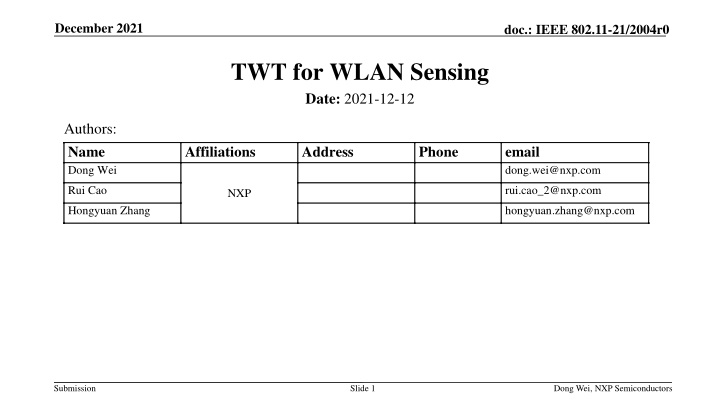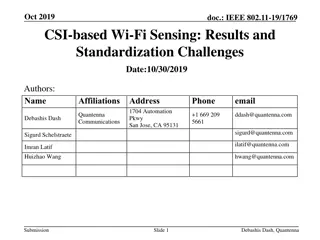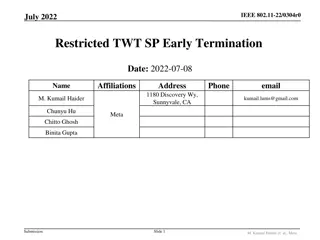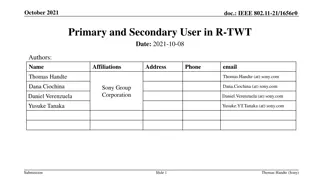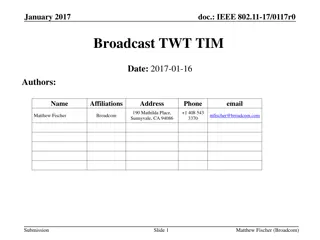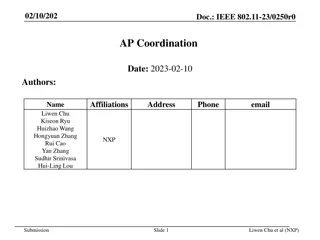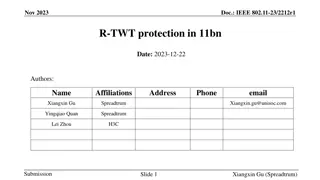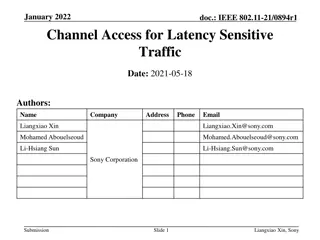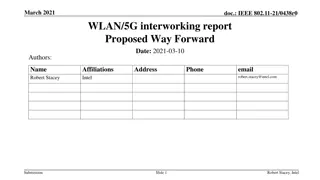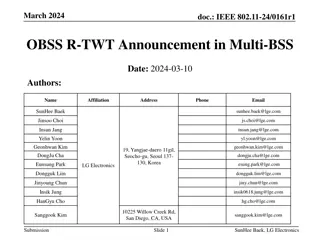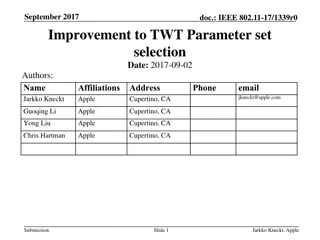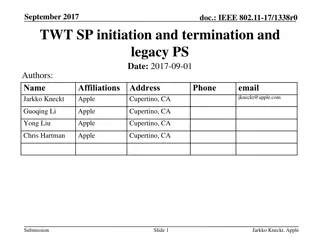IEEE 802.11-21/2004r0 Target Wake Time (TWT) for WLAN Sensing
This technical document delves into the implementation of Target Wake Time (TWT) in wireless local area networks (WLAN) for efficient power management in sensing devices. It explores the significance of TWT in minimizing contention among stations, reducing power consumption, and optimizing wake schedules between access points and stations. The negotiation process, types of TWT, and its benefits for battery-powered devices are thoroughly discussed.
Download Presentation

Please find below an Image/Link to download the presentation.
The content on the website is provided AS IS for your information and personal use only. It may not be sold, licensed, or shared on other websites without obtaining consent from the author.If you encounter any issues during the download, it is possible that the publisher has removed the file from their server.
You are allowed to download the files provided on this website for personal or commercial use, subject to the condition that they are used lawfully. All files are the property of their respective owners.
The content on the website is provided AS IS for your information and personal use only. It may not be sold, licensed, or shared on other websites without obtaining consent from the author.
E N D
Presentation Transcript
December 2021 doc.: IEEE 802.11-21/2004r0 TWT for WLAN Sensing Date: 2021-12-12 Authors: Name Dong Wei Affiliations Address Phone email dong.wei@nxp.com Rui Cao rui.cao_2@nxp.com NXP Hongyuan Zhang hongyuan.zhang@nxp.com Submission Slide 1 Dong Wei, NXP Semiconductors
September 2021 doc.: IEEE 802.11-21/2004r0 Motivation A broad range of wireless local area network (WLAN) sensing applications require long- term, periodic sensing measurement and reporting of measurement results. In these applications, low power consumption is a key requirement for battery-powered WLAN sensing devices. A previous contribution (11-21/1532) provided a high-level overview of Target Wake Time (TWT) for periodic sensing measurement and power saving. This contribution presents more details. Submission Slide 2 Dong Wei, NXP Semiconductors
September 2021 doc.: IEEE 802.11-21/2004r0 A Brief Overview of TWT Target wake time (TWT) allows an AP to manage activity in the BSS in order to minimize contention between STAs and to reduce the required amount of time that a STA utilizing a power management mode needs to be awake. This is achieved by allocating STAs to operate at nonoverlapping times and/or frequencies, and concentrate the frame exchanges in predefined service periods. (Clause 26.8 of 802.11ax-2021) With the TWT mechanism, a STA can agree with an AP on a wake schedule, allowing it to wake up only when required. [1] M. Nurchis and B. Bellalta, Target Wake Time: Scheduled Access in IEEE 802.11ax WLANs , IEEE Wireless Communications Magazine, April 2019. Submission Slide 3 Dong Wei, NXP Semiconductors
September 2021 doc.: IEEE 802.11-21/2004r0 Types of TWT Implicit TWT (TWT negotiation decides the start time of TWT and TWT wake interval) vs. explicit TWT (not supported in 11ax/be) Implicit TWT enables a periodic wake schedule. Individual TWT vs. broadcast TWT Mandatory support by HE/EHT AP for individual TWT Optional support by HE/EHT non-AP STA for individual TWT Optional support by HE/EHT AP/non-AP STA for broadcast TWT Since a sensing session is pairwise (Motion 23), individual TWT fits naturally. Trigger-enabled TWT (The AP transmits at least one trigger in each TWT service period (SP) to schedule STA s transmissions) vs. non-trigger-enabled TWT (No trigger is transmitted in any TWT SP, thus allowing the STA to decide when to transmit autonomously inside the TWT SP) Announced TWT (The TWT requesting STA may be at the doze state at the beginning of TWT SP and the AP transmits frames to the STA after receiving a PS-Poll/APSD trigger from the STA) vs. unannounced TWT (The TWT requesting STA shall wake up at the beginning of TWT SP) Submission Slide 4 Dong Wei, NXP Semiconductors
September 2021 doc.: IEEE 802.11-21/2004r0 TWT Negotiation To initiate the negotiation, the TWT-requesting STA communicates its waking schedule information to the AP via a TWT request message. The AP devises a schedule and delivers TWT parameter values in a response message to the STA. TWT: the next time at which the STA should wake up for the TWT session TWT wake interval: the time interval between subsequent TWT sessions for the STA It may require more than one pair of request-response messages to conclude the agreement negotiation phase. Once the TWT parameters are agreed, the STA can go to sleep until the next TWT SP starts. The STA wakes up and participates in sensing measurement periodically according to the schedule. TWT Setup/Teardown/Information frames are used to set up, tear down, and update a TWT agreement, respectively. TWT negotiation should be included in the sensing measurement setup for a sensing initiator and a sensing responder to exchange and agree on the TWT parameters associated with sensing measurement instances. Submission Slide 5 Dong Wei, NXP Semiconductors
September 2021 doc.: IEEE 802.11-21/2004r0 Example 1 TWT for Trigger Frame Sounding TWT-responding/scheduling AP: sensing initiator/receiver TWT-requesting/scheduled STA: sensing responder/transmitter After the STA agrees with the AP on a wake schedule for a trigger-enabled TWT, it transitions to the doze state. At the beginning of the first TWT SP, the AP transmits a trigger frame (TF) to solicitate NDP transmissions. The station wakes up, receives the TF, and transmits an NDP frame to the AP. The AP receives the NDP frame and performs sensing measurement. The STA goes to sleep until the start of the next TWT SP. The AP and the STA repeat the above process during each TWT SP. If unannounced TWT is used, the polling phase is not needed. TWT wake interval TWT SP TWT SP TWT Response AP TF TF (initiator) TWT Request doze doze STA NDP NDP (responder) Submission Slide 6 Dong Wei, NXP Semiconductors
September 2021 doc.: IEEE 802.11-21/2004r0 Example 2 TWT for NDPA Sounding TWT-responding/scheduling AP: sensing initiator/transmitter TWT-requesting/scheduled STA: sensing responder/receiver After the STA agrees with the AP on a wake schedule for an individual TWT, it transitions to the doze state. At the beginning of the first TWT SP, the AP transmits an NDPA frame followed by an NDP frame to the STA. The STA wakes up, receives the NDPA and NDP frames, performs measurement, and feedbacks measurement result. The STA goes to sleep until the start of the next TWT SP. The AP and the STA repeat the above process during each TWT SP. If unannounced TWT is used, the polling phase is not needed. TWT wake interval TWT SP TWT SP TWT Response AP (initiator) NDP NDPA NDP NDPA TWT Request STA doze doze measurement feedback measurement feedback (responder) Submission Slide 7 Dong Wei, NXP Semiconductors
September 2021 doc.: IEEE 802.11-21/2004r0 Example 3 TWT for Non-TB Sensing Measurement Recently, a non-AP STA-initiated non-trigger based (non-TB) sensing measurement instance received significant support (see DCN 11-21/1433r2). In 11az, availability window is not specifieded for non-TB ranging measurement exchange. TWT can be used to schedule periodical non-TB sensing measurement. It could be difficult to obtain periodical sensing measurements without TWT (i.e. the coordinated scheduling with the AP). This also improves the overall scheduling performance of the AP (e.g. to schedule data communication and/or sensing measurement with all STAs). TWT wake interval TWT service period TWT service period TWT response Report R2I NDP R2I NDP Report AP (responder) TWT request doze doze STA Sensing NDPA I2R NDP Sensing NDPA I2R NDP (initiator) Submission Slide 8 Dong Wei, NXP Semiconductors
September 2021 doc.: IEEE 802.11-21/2004r0 Example 4 TWT for Multiple Sensing Frequencies It is highly useful for the sensing measurement frequency to be adapted quickly to environment changes. This can be accomplished with TWT (as shown in the figure below): The AP and the STA can setup multiple TWT agreements between them. Each TWT agreement has a unique TWT wake interval corresponding to a unique sensing measurement frequency. A TWT Information frame can be exchanged to suspend the current active TWT agreement and resume a new TWT agreement. Sensing measurement instance TWT wake interval for high sensing frequency TWT wake interval for low sensing frequency TWT Information frame exchange Submission Slide 9 Dong Wei, NXP Semiconductors
September 2021 doc.: IEEE 802.11-21/2004r0 Example 5 TWT for Multiple Sensing Procedures An AP and a STA may have more than one sensing measurement procedure between them. Sensing measurement procedure 1: The STA initiates a non-TB measurement (without reporting) with a high measurement frequency Sensing measurement procedure 2: The AP operates a sensing by proxy procedure (for a client) and receives NDPs from the STA with a low measurement frequency As shown in the figure below, two TWT agreements are negotiated, one for each sensing measurement procedure. They may have different TWT service periods and TWT wake intervals. TWT wake interval for sensing measurement procedure 2 Measurement instance for procedure 1 Measurement instance for procedure 2 TWT wake interval for sensing measurement procedure 1 Submission Slide 10 Dong Wei, NXP Semiconductors
September 2021 doc.: IEEE 802.11-21/2004r0 Example 6 TWT for Joint Sensing and Communication Joint sensing and communication (JSAC) has been a hot topic in the literature. It is most common that a STA has dual functions: data communication and sensing. TWT is a useful tool for scheduling joint sensing and data communication. TWT was originally defined for data communication. As shown in the figure below, two TWT agreements are negotiated: one for data communication and the other for sensing. They may have different TWT service periods and TWT wake intervals. TWT wake interval for sensing Data Sensing TWT wake interval for data Submission Slide 11 Dong Wei, NXP Semiconductors
September 2021 doc.: IEEE 802.11-21/2004r0 Target Wake Time versus Availability Window Availability Window TWT Standards 11az 11ax/11be Association Associated and non-associated STAs Associated STAs only Support of data communication No Yes Number of active agreements Single Up to 8 Support of TB measurement Yes Yes (polling may not be needed) Support of Non-TB measurement No Yes Flexibility Limited High Submission Slide 12 Dong Wei, NXP Semiconductors
September 2021 doc.: IEEE 802.11-21/2004r0 Summary A follow-up discussion on TWT-based WLAN sensing measurement has been presented. Being specified in 11ax and 11be, TWT is a versatile suite of scheduling tools. Using TWT, each sensing STA negotiates awake periods with the sensing AP to transmit and/or receive NDPs for sensing measurement and reporting, saving energy the rest of the time as the STA remains in the doze state. Enables scheduling of periodic wake time for sensing measurement Leads to low energy consumption for the participating sensing STAs Provides flexibility in how the transmission period can be used for exchange of sensing information Facilitates joint sensing and communication To summarize, TWT is a unique tool for the highly useful combination of efficiency, power saving, and flexible schedules. Submission Slide 13 Dong Wei, NXP Semiconductors
September 2021 doc.: IEEE 802.11-21/2004r0 SP Do you agree with the following? o 11bf shall add the following to the WLAN sensing procedure to facilitate the use of the Target Wake Time (TWT) mechanism specified in 11ax/11be: TWT setup is included in the sensing measurement setup. At least one sensing measurement instance is scheduled in each TWT service period. The termination of a sensing measurement setup shall result in the teardown of all the TWT agreement(s) associated with the sensing measurement setup. (The details of this teardown is specified in the handshake protocol for sensing measurement termination, which is TBD.) The teardown of any TWT agreement does not result in termination of the associated sensing measurement setup. Support of types of TWT are TBD. Submission Slide 14 Dong Wei, NXP Semiconductors
